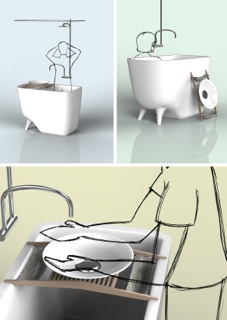Hansgrohe Award 2014: Efficient Water Design presented to young international designers
Sustainability and efficiency in association with water is an international topic.
This year’s competition for the Hansgrohe Award for sustainable design concepts around the topic of water chose five winners out of 180 submissions from around the world. The awards were presented for the fourth time within the realms of the iF concept design award 2014. These five best concepts were honored in Hamburg, Germany.

|
|
Houdini is a 3-in-1 solution that is ideal for small bathrooms. Photo courtesy of iF Concept Design Award 2014. |
The prize money, totaling 5.000 Euros (6,732.50 US dollars), is divided among the winners, who come from China, Sweden, the Czech Republic and Germany.
Philippe Grohe, head of the designer brand Axor at Hansgrohe SE, said, “As the initiator and sponsor of the ‘Hansgrohe Award 2014: Efficient Water Design’, we want to give young designers the opportunity to address the element of water, and to present their ideas to an expert jury. This year’s submissions show interesting approaches to efficient water design. I was particularly pleased to see the large number of international submissions — these clearly show that the interplay of water and space is gaining importance with young designers from all over the world.”
The jury members included Andreas Haug, one of the founders and partners of Phoenix Design in Stuttgart; Axel Meissner, Hansgrohe product manager; and Philippe Grohe
Winners of the Hansgrohe Award 2014
- The “Houdini” concept by Christoffer Ohlander (Konstfack University, Stockholm, Sweden) won 1.500 Euros. Houdini is a 3-in-1 solution that is ideal for small bathrooms and combines three functions: sink, shower and bathtub.
- The “Puro” concept from Fabrice Hoefgen from the University of Applied Sciences in Darmstadt, Germany, won 1.500 Euros. The Puro is a sink whose wave-like, flat design is resembles the natural movement of water with a stainless-steel stone in the center.
- The “Elastigenic” concept from Petr Strejcek (Czech Technical University) won 1.000 Euros. The Elastigenic bathroom consists primarily of an elastic material that can be used to form such objects as a sink, a bathtub, towel racks and handle bars, etc.
- The “Kengai” concept from Oliver Keyerleber and Fabian Bitter (Hochschule Coburg, Germany) won 500 Euros. The Kengai concept shower is made up of three cascading modules with different functions. The water pours like rain from the top, then flows through a steam and an herb module to create a natural shower experience.
- The “Energy-saving shower” concept from Xiangying Li (Huaqiao University, Xiamen, China) won 500 Euros. The energy-saving shower combines minimalistic design with functional style elements that help save both water and energy by allowing the water heating component be a visible design element.
HELPFUL LINKS:
Looking for a reprint of this article?
From high-res PDFs to custom plaques, order your copy today!




